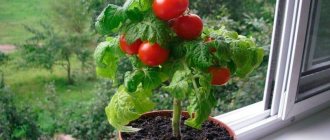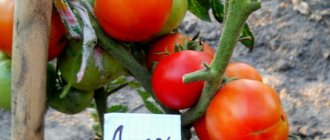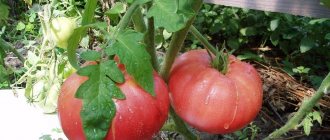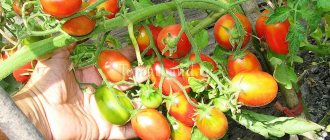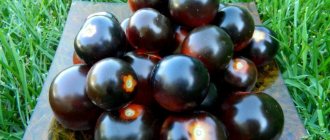For those who prefer an agricultural lifestyle, there is an interesting tomato. The highlight of the Snow Leopard is its giant fruits, which ripen quickly compared to other large-fruited representatives.
| Height | Landing location | Ripening time | Fruit color | Fruit size | Origin | Fruit shape |
| short | Greenhouse, Open ground | Early ripening | Reds | Large | Variety | Flat-round |
Description and characteristics of the variety
The Snow Leopard tomato is a determinate, easy-to-plant variety. It is not capricious and sets fruit well in bad weather, in heat and slush. Ripens early - 90-104 days from germination.
Characteristics of bushes:
- shoot height is within 60-80 cm;
- 4-5 tomatoes are formed on the bunches;
- number of fruiting clusters 7-9;
- good foliage;
- moderate branching.
Description of fruits:
- average weight 220-240 g;
- large specimens weigh up to 300 g;
- the color is bright red-orange;
- round shape;
- the pulp is oily, moderately juicy;
- Rich tomato taste with hints of sweetness.
Origin and application
The variety belongs to Russian selection. Designed for planting in various regions. Fruits successfully in open areas and greenhouse beds.
Tomatoes are ideal for a variety of dishes. Salads and slices are prepared from them. Canned whole for the winter and salted. Juices and pastes are tasty and aromatic.
Advantages and disadvantages
In addition to the mentioned advantages (cold resistance, early ripening and balanced taste), the tomato has a number of other positive qualities:
- Versatility of use - for salads, culinary processing and canning.
- The fruits are not prone to cracking.
- Resistance to B]late blight[/anchor] and fusarium.
- It tolerates transportation well and can be stored for up to 2 months.
- Tomatoes picked green ripen well at room temperature.
- Easy to care for.
- Good yield - from one bush you can get up to 3 kg of tomatoes.
Disadvantages of the variety:
- despite the short stature of the tomato, it needs tying and support;
- in the case of development of lateral shoots, the bush can behave as semi-determinate.
Features of cultivation and storage
Fertilizers are applied to the planting area. Be sure to use compost, superphosphate, and saltpeter.
There are 4 bushes per 1 m2. Maintain a standard distance of 40-50 cm. The distance between furrows is 60 cm.
How to care:
- Irrigation with Bordeaux mixture at risk of fungal infection.
- Moderate watering at the root level at the rate of 6-8 liters.
- Carrying out regular fertilizing at least 2 times a month.
- Formation into 2-3 shoots.
- Fixation to a strong support.
What is used for fertilizer? The most effective way is to water the beds with a mullein solution diluted 1:10. Bio-infusions made from nettle and sedum are popular. Complex products are desirable during flowering and ripening.
Agrotechnics of cultivation
The characteristics and descriptions of the variety provided by experienced gardeners make it possible to choose a method for growing Snow Leopard. Tomatoes can be sown as seedlings, transplanting them into a greenhouse or into beds, but tomatoes sown directly into the ground also grow well (seedless method). In the second case, you can get tomatoes closer to the second half of summer.
Early ripe tomatoes for seedlings should be sown 50-60 days before transplanting to a permanent location. For sowing, use a mixture of garden soil, sand and humus, taken in equal proportions. To disinfect, the soil in the box is thoroughly soaked in a hot solution of potassium permanganate and left until it cools. After this, the seeds are distributed over the surface and covered with a thin layer of dry sand (0.5 cm). Germinate seeds in a warm place (+25°C), under glass or film.
When 2-3 leaves appear on the seedlings, you can start picking the seedlings. In this case, the sprouts are dug up and transplanted into separate containers or boxes according to a 10x10 cm pattern. In mid-May, you can plant them in a greenhouse, and in early June - in open ground.
Planting a tomato
This crop is grown by seedlings and seeds, in open ground and under film. It is recommended to pre-treat the planting material with a growth stimulator.
The soil must be nutritious and moist. With the seedless method, they dig it up, apply complex mineral fertilizer or humus, and disinfect it. For seedlings, a nutrient substrate is prepared based on garden or turf soil, humus, river sand, vermiculite and wood ash (optional). Sowing is carried out at the end of February or at the beginning of March.
The health and sustainability of a vegetable crop directly depends on the quality of the seeds. If they were initially infected, then it is a priori impossible to obtain a rich harvest. Let's look at the basic recommendations for planting and caring for the Snow Leopard tomato.
- It is recommended to plant seeds in a nutrient substrate of turf soil, humus, and peat. The substrate can be bought at the store or prepared yourself.
- The prepared substrate contains a large number of bacteria and fungal spores, which must be destroyed so that they do not infect the tomato planted in it. For disinfection, you can use a time-tested one percent solution of potassium permanganate or modern biological preparations “Fitosporin”, “Trichodermin”. It is necessary to saturate the soil completely to be sure of the destruction of pathogenic microflora.
- To increase the germination of seeds, they are soaked in a solution based on the growth stimulator “Zircon”. Dissolve no more than 3 drops of the drug in 300 milliliters, stir the mixture, after which the seeds are placed in it for 8-18 hours.
- Seeds should be sown in heated soil mixture. The soil and air temperature must be at least 22°C. The seeds are placed in a container with a prepared substrate to a depth of no more than 1 centimeter, after which they are carefully watered with warm water. The first shoots will appear 7-8 days after planting. Seedlings need to be watered with warm water every other day, ensure that the soil dries out, and avoid excessive accumulation of moisture, so as not to provoke rotting of the roots.
- The seedlings are transplanted into greenhouses or garden beds 50-60 days after sowing the seeds. Two weeks before the day of planting, the seedlings must be hardened off if you are going to cultivate the plants in open ground.
- Fertilizers, 50 grams of saltpeter and 50 grams of superphosphate per square meter must be added to the dug holes for seedlings. Plants are planted at an angle of 45 degrees.
We invite you to familiarize yourself with perennial Rudbeckia: planting and care in open ground
Tomato care
After planting the seedlings, the tomato care stage begins. The main elements include:
- timely watering. Tomato responds well to moisture. It is necessary to water with non-ice water so that the plant does not get sick. It is recommended to irrigate tomatoes once every five days. Water consumption per bush is 2-3 liters.
- removing weeds from the garden.
- loosening the soil.
- treatment of plants when diseases and pests appear. Most often, the Snow Leopard tomato is attacked by pests: aphids, spider mites, caterpillars. To combat insects, use the complex drug "Aktara".
- During the flowering period, you need to make a liquid fertilizer based on mullein. Preparation of fertilizer: dissolve 5 kg in 5 liters of water. manure, leave to infuse for a day. After 24 hours, you need to take 2 liters of the resulting slurry, dilute it in 10 liters of water and water each bush at the root. Consumption per plant is 1 liter.
Landing
This crop is grown by seedlings and seeds, in open ground and under film. It is recommended to pre-treat the planting material with a growth stimulator.
The soil must be nutritious and moist. With the seedless method, they dig it up, apply complex mineral fertilizer or humus, and disinfect it. For seedlings, a nutrient substrate is prepared based on garden or turf soil, humus, river sand, vermiculite and wood ash (optional). Sowing is carried out at the end of February or at the beginning of March.
Bush care
“Snow Leopard” bushes are distinguished by significant spreading and increased formation of stepsons. Therefore, for normal growing season, plants are regularly thinned out and formed into 1-2 stems. Growth shoots are pinched when they reach a length of 60 cm. No more than 5 flowers are left on one bush. It is also recommended to remove side shoots and lower leaves. This is necessary to improve ventilation and balanced light distribution.
We invite you to familiarize yourself with Cabernet Sauvignon grape variety description
Other rules of agricultural technology:
- Shallow watering with warm water as the soil dries out;
- Loosening the soil between waterings;
- Installation of supports for heavy fruiting clusters;
- Fertilizing with complex fertilizers once every 14 days.
Caring for the variety in question consists of the usual agrotechnical measures for tomatoes:
- weeding;
- feeding;
- watering (infrequent);
- pest control.
Growing tomatoes
Snow Leopard seeds have excellent germination, which allows them to be grown even without seedlings. In this case, the seeds are placed in holes spilled with hot potassium permanganate, watered with warm water and covered with film until shoots appear. It is recommended to sow in open ground in the first ten days of June, when the ground warms up to 12-15*C.
How to prepare seeds?
Seeds must meet the requirements:
- Taken from tomatoes grown on healthy and strong plants;
- Extracted from tomato slurry during the fermentation stage;
- Complete, without traces of damage, mold, chips;
- Uniformly colored.
IMPORTANT: All procedures must be carried out under sterile conditions to avoid contaminating the seeds with bacteria found on dirty containers or unwashed hands.
The originator supplies the seeds untreated, so the gardener must carry out the pre-sowing treatment himself. It includes the following steps:
- Soaking in a saline solution (1 teaspoon of salt per glass of water) to identify empty seeds. After mixing, they remain on the surface for 5 minutes;
- Disinfection in a solution of calcium permanganate (10 mg per 50 ml of water) with the addition of a growth stimulator (Epin, Zircon, Kornevin);
- “Awakening” of seeds in purified water for 12 hours.
Sowing seed material
Seeds for seedlings are sown 2 months before planting in a permanent place. The substrate is bought in the store (“Universal”, “For tomato and pepper”) or made independently. To do this, mix garden turf, pre-steamed to 60*C, peat and sand in proportions 2:1:1 and add 10% humus.
Sowing order:
- Pour the substrate into a container with a layer of 5 cm on top of 2 cm of drainage;
- Make grooves 1.5 cm deep in the ground and spray them with “Humate”;
- Place seeds in grooves at intervals of 2 cm;
- Sprinkle with peat, pour with warm water and cover with film, creating a mini-greenhouse with a temperature of 28 * 30 * C;
- After emergence of seedlings, remove the cover and continue growing at a temperature of 22-24*C.
Seedlings require constant watering, draft-free ventilation, and periodic fertilizing with complex fertilizers. Picking is carried out at the growth stage of the 3rd true leaf.
Rules for planting seedlings
Planting in a greenhouse is carried out in the second half of May, in open ground - in early June. By this time, the seedlings should stretch up to 30 cm and have 5-6 true leaves. Traditional planting pattern:
- The interval between bushes is 40 cm;
- Row spacing – 60 cm;
- Embedment depth – 15 cm;
- The maximum planting density is 6 bushes per 1 sq.m.
Plants are taken from a pot with a large lump of earth so as not to injure the root system. It’s even better to plant it together with the container to avoid transplantation. To do this, at the picking stage, the bushes need to be planted in peat pots or paper cups.
Growing Tomato Snow Leopard
The Snow Leopard tomato allows you to get high yields in regions with cold climates. The variety is distinguished by its unpretentiousness and early fruiting. It can be cultivated in greenhouses or open ground under temporary shelter.
Growing Tomato Snow Leopard
Brief information about the variety
- Fruits and bush : red tomatoes with an orange tint, round, slightly flattened, weighing from 120 to 200 g; determinate bush, 50-70 cm high.
- Productivity : high (2.5-4 kg per bush).
- Resistance : high to most diseases.
- Distribution : Recommended for all regions.
- Application : salads, pickling and canning, main courses, processing.
- Planting : seedling method; sowing - at the end of February or early March, transplanting into a greenhouse - at the beginning of May, into open ground - in the second half of May; planting pattern – 40×50 cm.
- Soil : light, slightly acidic.
- Care : watering - every 7-10 days, fertilizing - 3 times per season, formation - 1-2 stems, it is advisable to tie or support heavy brushes.
- Ripening period : early ripening, tomatoes ripen 95-105 days after emergence. It is possible to store the crop for 2 weeks.
Characteristic
The Snow Leopard tomato variety is an early variety: it begins to produce crops 95-105 days after germination. The fruits are set in clusters of 4-6 pieces.
Description of the bush and fruits
Bushes of determinate type with a height of 50 to 70 cm. They grow well leafy.
The color of the tomatoes is red with an orange tint. The shape is round, slightly flattened, with ribbing at the stalk. The weight of the fruit is 120-200 g, but some tomatoes can reach a weight of 300 g. The skin is strong, the flesh is dense and fleshy. The taste is sweet and sour.
Area of application of fruits
Snow Leopard tomatoes are suitable for preparing salads, stews and baked dishes. A medium-sized, dense tomato is good for pickling and canning. In addition, the fruits can be processed: made into thick juice, ketchup, and tomato paste.
Productivity and fruiting
From 2.5 to 4 kg of tomatoes are harvested from one bush - this is an excellent yield for a low-growing variety.
According to descriptions from gardeners, the volume of the harvest depends to a greater extent on the correct formation of the bush than on fertilizing or weather conditions.
The variety bears fruit quickly; it occurs in several stages and lasts until the end of summer.
Disease resistance
Snow Leopard tomatoes are resistant to most diseases. However, judging by the reviews, the variety can become infected with late blight from other bushes. This usually happens at the end of fruiting (in such cases, the tomatoes are immediately collected and allowed to ripen at home).
Tatyana Orlova (Vasilidchenko) (candidate of agricultural sciences):
If a tomato plant is infected with late blight, then the fruits from such plants, collected green, often do not ripen in storage, but rot, because On their surface, invisible fungal spores remain. To prevent this from happening, the collected green fruits are placed in hot water at a temperature of 60-65 degrees for a few seconds, dried and stored in boxes.
Advantages and disadvantages
Plants are easy to care for
The positive characteristics of the variety include:
- high yield (4 kg per bush);
- early ripening;
- unpretentiousness to soil, watering and fertilizing;
- resistance to most diseases;
- high resistance to cold and weather changes;
- universally applicable fruits with good keeping quality;
- compactness of bushes.
Among the disadvantages of the Snow Leopard tomato are:
- the need to form bushes;
- can become infected with late blight from other tomatoes.
Features of cultivation
Seeds are sown at the end of February or at the beginning of March (if necessary, the seedlings are illuminated with a lamp). Transplantation into the greenhouse is carried out in early May. When grown in open ground, sowing and transplanting are done 2-3 weeks later.
The Snow Leopard tomato can be planted directly with seeds in the ground, but this method is more suitable for the southern regions (in the middle zone and northern Russia, tomatoes will take a long time to ripen and will yield much smaller yields).
Sowing seedlings
Before sowing, it is necessary to prepare the soil and seeds. The soil from the garden is mixed with ready-made soil mixture for growing seedlings (in equal proportions). The purchased composition contains all the substances necessary for plants, and the garden soil will help the tomatoes adapt to new conditions when transplanting.
The seeds are kept in a solution of potassium permanganate for 20-30 minutes. and treated with a growth stimulator. If desired, they can be germinated in damp tissue before sowing.
Seeds of the Snow Leopard variety are deepened into the soil by 0.5-1 cm, moistened with warm water and covered with film. The temperature is set within 23-25 °C, and after emergence it is lowered to 16 °C (for one week). The seedlings are watered with warm water once a week.
When 2 true leaves appear, seedlings are planted in separate pots. A week before transplantation, hardening is carried out: every day the seedlings are taken outside or the windows are opened in the room.
Transplanting into a greenhouse or open ground
Rotted manure is added to the soil in the garden bed, dug up and loosened. The holes are placed according to a 40x50 cm pattern. If you plan to form the bushes into one stem, you can leave 35 cm between the holes. A large handful of wood ash and 1 tsp are added to each hole. superphosphate, pour in 1-1.5 liters of settled water. Plants are planted in holes, hilled and mulched.
